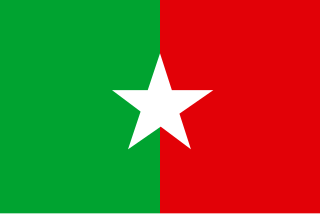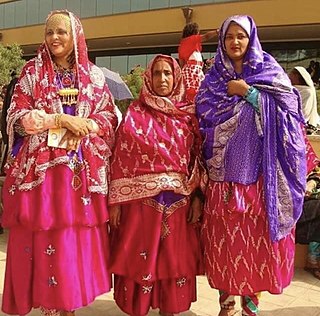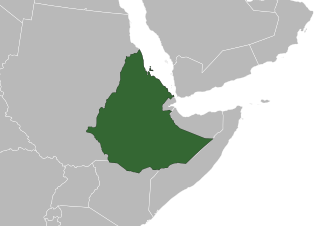
Conflicts in the Horn of Africa have been occurring since the 17th century BCE. The Horn of Africa includes the nations of Djibouti, Eritrea, Ethiopia, and Somalia

Conflicts in the Horn of Africa have been occurring since the 17th century BCE. The Horn of Africa includes the nations of Djibouti, Eritrea, Ethiopia, and Somalia

{{Infobox | bodyclass = geography | above = Horn of Africa | image = | label1 = Countries

Ogaden is one of the historical names used for the modern Somali Region which forms the eastern portion of Ethiopia and which borders Somalia. Before 1995 most of Ogaden was part of Ethopia's Hararghe province. The other names sometimes used for this area are Haud or Hawd.

Greater Somalia is an irridentist concept to unite all ethnic Somalis comprising the regions in or near the Horn of Africa in which ethnic Somalis live and have historically inhabited. The territory historically encompassed British Jubaland Province, British Somaliland, Italian Somaliland, parts of French Somaliland, the Somali Region in Ethiopia, the Northern Frontier District in Kenya, and the intra-46th meridian east territories. At the present, it encompasses Somalia proper, Jubaland, southern and eastern Djibouti, the Somali Region and Dire Dawa in Ethiopia, and the Garissa, Wajir and Mandera Counties in Kenya. A few sources even included the islands of Socotra, Abd al Kuri, Samhah, Darsah, Sabuniyah and the Ka'l Fir'awn islands in Yemen's Socotra Archipelago.

The Western Somali Liberation Front was a separatist rebel group fighting in eastern Ethiopia to liberate the Ogaden region from Ethiopian control. It played a major role in the Ogaden War of 1977-78 assisting the invading Somali Army.
The Dir is one of the largest and most prominent Somali clans in the Horn of Africa. They are also considered to be the oldest Somali stock to have inhabited the region. Its members inhabit Djibouti, Somalia, Ethiopia, and northeastern Kenya.

The Eritrean War of Independence was a war for independence which Eritrean independence fighters waged against successive Ethiopian governments from 1 September 1961 to 24 May 1991.

The Ethiopian–Somali conflict is a territorial and political dispute between Ethiopia, Somalia, and insurgents in the area, Originating in the 1300s, the conflict's most recent iteration began in the late 1940s when the Somali-inhabited Ogaden region was handed back to Ethiopia by the British. In the years following, tensions culminated in numerous insurgencies and several wars. However, because of the Somali Civil War and the lack of a functioning central government since the collapse of the Democratic Republic of Somalia in 1991, Ethiopia has the upper hand militarily and economically.

The Ethiopian Empire, also formerly known by the exonym Abyssinia, or simply known as Ethiopia, was a sovereign state that historically encompasses the geographical area of present-day Ethiopia and Eritrea from the establishment of the Solomonic dynasty by Yekuno Amlak approximately in 1270 until the 1974 coup d'etat by the Derg, which dethroned Emperor Haile Selassie. By 1896, the empire incorporated other regions such as Hararghe, Gurage and Wolayita, and saw its largest expansion with the federation of Eritrea in 1952. Throughout much of its existence, it was surrounded by hostile forces in the African Horn; however, it managed to develop and preserve a kingdom based on its ancient form of Christianity.

The military history of Ethiopia dates back to the foundation of early Ethiopian Kingdoms in 980 BC. Ethiopia has been involved in many of the major conflicts in the horn of Africa, and was one of the few native African nations which remained independent during the Scramble for Africa, managing to create a modern army. 19th and 20th century Ethiopian Military history is characterized by conflicts with the Dervish State, Mahdist Sudan, Egypt, and Italy, and later by a civil war.

The Harari people are a Semitic-speaking ethnic group which inhabits the Horn of Africa. Members of this ethnic group traditionally reside in the walled city of Harar, simply called Gēy "the City" in Harari, situated in the Harari Region of eastern Ethiopia. They speak the Harari language, a member of the South Ethiopic grouping within the Semitic subfamily of the Afroasiatic languages.

The military history of Somalia encompasses the major conventional wars, conflicts and skirmishes involving the historic empires, kingdoms and sultanates in the territory of present-day Somalia, through to modern times. It also covers the martial traditions, military architecture and hardware employed by Somali armies and their opponents.

Ethiopian nationalism, also referred to as Ethiopianism or Ethiopianness, according to its proponents, asserts that Ethiopians are a single nation, and promotes the social equality of all component ethnic groups. Ethiopian people as a whole regardless of ethnicity constitute sovereignty as one polity. Ethiopian nationalism is a type of civic nationalism in that it is multi-ethnic in nature, and promotes multiculturalism.
The military history of Djibouti encompasses the major conflicts involving the historic empires and sultanates in the territory of present-day Djibouti, through to modern times. It also covers the martial traditions and hardware employed by Djiboutian armies and their opponents.

Beginning with the Kingdom of Aksum, Ethiopia's territory evolved significantly through conquest of the lands surrounding it. Strong Aksumite trading partnerships with other world powers gave prominence to its territorial expansion. In 330, Aksum besieged the Nubian city of Meroë, marking the beginning of its great expansion. It finally declined after the rise of Islamic dominion in South Arabia, and it ultimately collapsed in the 10th century.

The fall of the Derg, also known as Downfall of the Derg, was a military campaign that resulted in the defeat of the ruling military junta, called the Derg by the rebel coalition Ethiopian People's Revolutionary Democratic Front (EPRDF) on 28 May 1991 in Addis Ababa, ending the Ethiopian Civil War. The Derg took power after deposing Emperor Haile Selassie and the Solomonic dynasty, an imperial dynasty of Ethiopia that began in 1270. The Derg suffered from insurgency with different factions, and separatist rebel groups since their early rule, beginning with the Ethiopian Civil War. The 1983–1985 famine, the Red Terror, and resettlement and villagization made the Derg unpopular with the majority of Ethiopians tending to support insurgent groups like the Tigray People's Liberation Front (TPLF) and Eritrean People's Liberation Front (EPLF).
The 1995 Ethiopian Federal Constitution formalizes an ethnic federalism law aimed at undermining long-standing ethnic imperial rule, reducing ethnic tensions, promoting regional autonomy, and upholding unqualified rights to self-determination and secession in a state with more than 80 different ethnic groups. But the constitution is divisive, both among Ethiopian nationalists who believe it undermines centralized authority and fuels interethnic conflict, and among ethnic federalists who fear that the development of its vague components could lead to authoritarian centralization or even the maintenance of minority ethnic hegemony. Parliamentary elections since 1995 have taken place every five years since enactment. All but one of these have resulted in government by members of the Ethiopian People's Revolutionary Democratic Front (EPRDF) political coalition, under three prime ministers. The EPRDF was under the effective control of the Tigray People's Liberation Front (TPLF), which represents a small ethnic minority. In 2019 the EPRDF, under Abiy, was dissolved and he inaugurated the pan-ethnic Prosperity Party which won the 2021 Ethiopian Election, returning him as prime minister. But both political entities were different kinds of responses to the ongoing tension between constitutional ethnic federalism and the Ethiopian state's authority. Over the same period, and all administrations, a range of major conflicts with ethnic roots have occurred or continued, and the press and availability of information have been controlled. There has also been dramatic economic growth and liberalization, which has itself been attributed to, and used to justify, authoritarian state policy.

Somalis in Ethiopia refers to ethnic Somalis residing in Ethiopia, particularly in the Somali Region. Their language is primarily Somali and are majority Islam adhering. According to 2008 census based on Central Statistical Authority, Somali was the third largest ethnic group in Ethiopia with 4,560,000 population, accounting 6.2% after Oromo (34.4%) and Amhara (27%). The Somali population in Ethiopia makes up around 30% of the total Somali population.

The Ethiopia–Somalia border stretches 1,500 kilometers. In the 19th century, both Britain and Italy contributed to shaping the modern border, on behalf of their colonies of British and Italian Somaliland. The Somali people were thus under British, French, Italian and Ethiopian rule. During World War II, Britain gained control of the Ogaden and Haud territories and returned them to Ethiopia in 1954, but not delimited beyond the provisional line. Since 1960 independence, the border suffered serious skirmish involving both countries soldiers. From 1977 to 1978, Ethiopia and Somalia fought Ogaden War led by Colonel Mengistu Haile Mariam and General Siad Barre respectively. The EPRDF government demarcated the border of Ogaden into Somali Region. Somalia is located at the base of Ethiopia's protrude southeast region; from South, it is bounded by Wabi Shebelle and Genale Valley.